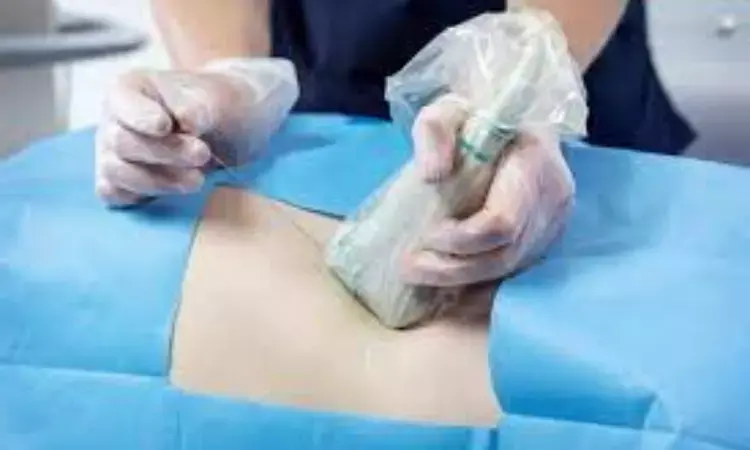- Home
- Medical news & Guidelines
- Anesthesiology
- Cardiology and CTVS
- Critical Care
- Dentistry
- Dermatology
- Diabetes and Endocrinology
- ENT
- Gastroenterology
- Medicine
- Nephrology
- Neurology
- Obstretics-Gynaecology
- Oncology
- Ophthalmology
- Orthopaedics
- Pediatrics-Neonatology
- Psychiatry
- Pulmonology
- Radiology
- Surgery
- Urology
- Laboratory Medicine
- Diet
- Nursing
- Paramedical
- Physiotherapy
- Health news
- Fact Check
- Bone Health Fact Check
- Brain Health Fact Check
- Cancer Related Fact Check
- Child Care Fact Check
- Dental and oral health fact check
- Diabetes and metabolic health fact check
- Diet and Nutrition Fact Check
- Eye and ENT Care Fact Check
- Fitness fact check
- Gut health fact check
- Heart health fact check
- Kidney health fact check
- Medical education fact check
- Men's health fact check
- Respiratory fact check
- Skin and hair care fact check
- Vaccine and Immunization fact check
- Women's health fact check
- AYUSH
- State News
- Andaman and Nicobar Islands
- Andhra Pradesh
- Arunachal Pradesh
- Assam
- Bihar
- Chandigarh
- Chattisgarh
- Dadra and Nagar Haveli
- Daman and Diu
- Delhi
- Goa
- Gujarat
- Haryana
- Himachal Pradesh
- Jammu & Kashmir
- Jharkhand
- Karnataka
- Kerala
- Ladakh
- Lakshadweep
- Madhya Pradesh
- Maharashtra
- Manipur
- Meghalaya
- Mizoram
- Nagaland
- Odisha
- Puducherry
- Punjab
- Rajasthan
- Sikkim
- Tamil Nadu
- Telangana
- Tripura
- Uttar Pradesh
- Uttrakhand
- West Bengal
- Medical Education
- Industry
Ultrasound-guided supraclavicular block for ulnar nerve block: Intertruncal and corner-pocket methods

When it comes to most upper limb procedures, supraclavicular block (SCB) is extremely successful; yet, it is linked to problems including pneumothorax and ulnar nerve sparing. The deep position of the lower trunk inside the neural clusters and the placement of nerve trunks close to the pleura are the primary causes of these difficulties. With fewer difficulties, precise local anaesthetic deposition under ultrasonographic (USG) supervision may lessen the likelihood of ulnar nerve sparing and the need for local anaesthetics. The intertruncal approach, a more contemporary SCB procedure, blocks the brachial plexus's individual trunks. Researchers recently evaluated that the intertruncal technique produces a total blockage of the ulnar nerve.
Eighty-eight patients were randomly assigned to undergo SCB using an intertruncal or corner-pocket technique guided by ultrasound (USG). The primary focus of the comparison was the complete motor and sensory blockade of the ulnar nerve as well as all four nerves (ulnar, radial, median, and musculocutaneous nerves) at the 15-minute mark. The length of the ulnar nerve's sensory blockage, patient pain score, time to surgical readiness, and block performance time were all secondary goals. An independent t-test was used to compare continuous data, while a Chi-square test was used to analyse categorical data. At 15 minutes, the intertruncal group had a substantially larger percentage of patients with full sensory (30/44 vs. 14/44, P < 0.001) and complete motor (22/44 vs. 7/44, P < 0.001) blocks in the ulnar nerve and all four nerves. The intertruncal group had a greater block performance time and patient pain level (P < 0.001). In the corner-pocket group, there was a longer overall duration of sensory blockage in the ulnar nerve (P < 0.001).
The intertruncal method of USG-guided SCB had a considerably larger percentage of individuals with a full ulnar nerve blockage at 15 minutes than the USG-guided corner-pocket technique. For a better result of SCB regarding the ulnar nerve blocking, the intertruncal technique may be an option. In the current investigation, the intertruncal group's block performance time was noticeably longer. The longer block performance time in the intertruncal group may be explained by the need for ideal image conditions with all three trunks distinct in the intertruncal approach as opposed to the corner-pocket approach, where drug deposition is only required upon visualising SCA with the brachial plexus lateral to it.
Reference –
Trivedi, Saurabh; Gupta, Srishti1; Bhardwaj, Hemendra; Sahoo, Tapan Kumar; Gupta, Seema; Trivedi, Gaurav2. Efficacy of intertruncal and corner-pocket approaches of ultrasound-guided supraclavicular block in terms of ulnar nerve blockade: A randomised controlled study. Indian Journal of Anaesthesia 67(9):p 778-784, September 2023. | DOI: 10.4103/ija.ija_45_23.
MBBS, MD (Anaesthesiology), FNB (Cardiac Anaesthesiology)
Dr Monish Raut is a practicing Cardiac Anesthesiologist. He completed his MBBS at Government Medical College, Nagpur, and pursued his MD in Anesthesiology at BJ Medical College, Pune. Further specializing in Cardiac Anesthesiology, Dr Raut earned his FNB in Cardiac Anesthesiology from Sir Ganga Ram Hospital, Delhi.
Dr Kamal Kant Kohli-MBBS, DTCD- a chest specialist with more than 30 years of practice and a flair for writing clinical articles, Dr Kamal Kant Kohli joined Medical Dialogues as a Chief Editor of Medical News. Besides writing articles, as an editor, he proofreads and verifies all the medical content published on Medical Dialogues including those coming from journals, studies,medical conferences,guidelines etc. Email: drkohli@medicaldialogues.in. Contact no. 011-43720751


